Polar Verity Sense
Two-minute review
The Polar Verity Sense is a heart rate monitor that lives on your upper arm as opposed to your wrist or chest and promises to deliver real-time heart rate data during exercise that Polar claims is on par with a chest strap monitor for accuracy.
This is Polar’s second armband monitor and shares a lot of similarities with its first, the OH1 and OH1+, with the Sense using the same-sized optical sensor technology to deliver the data. It can still transmit heart rate information to multiple devices, record sessions on the device itself and has a dedicated swimming mode with an improved swimming clip now included to keep it securely in place when you’re in the water.
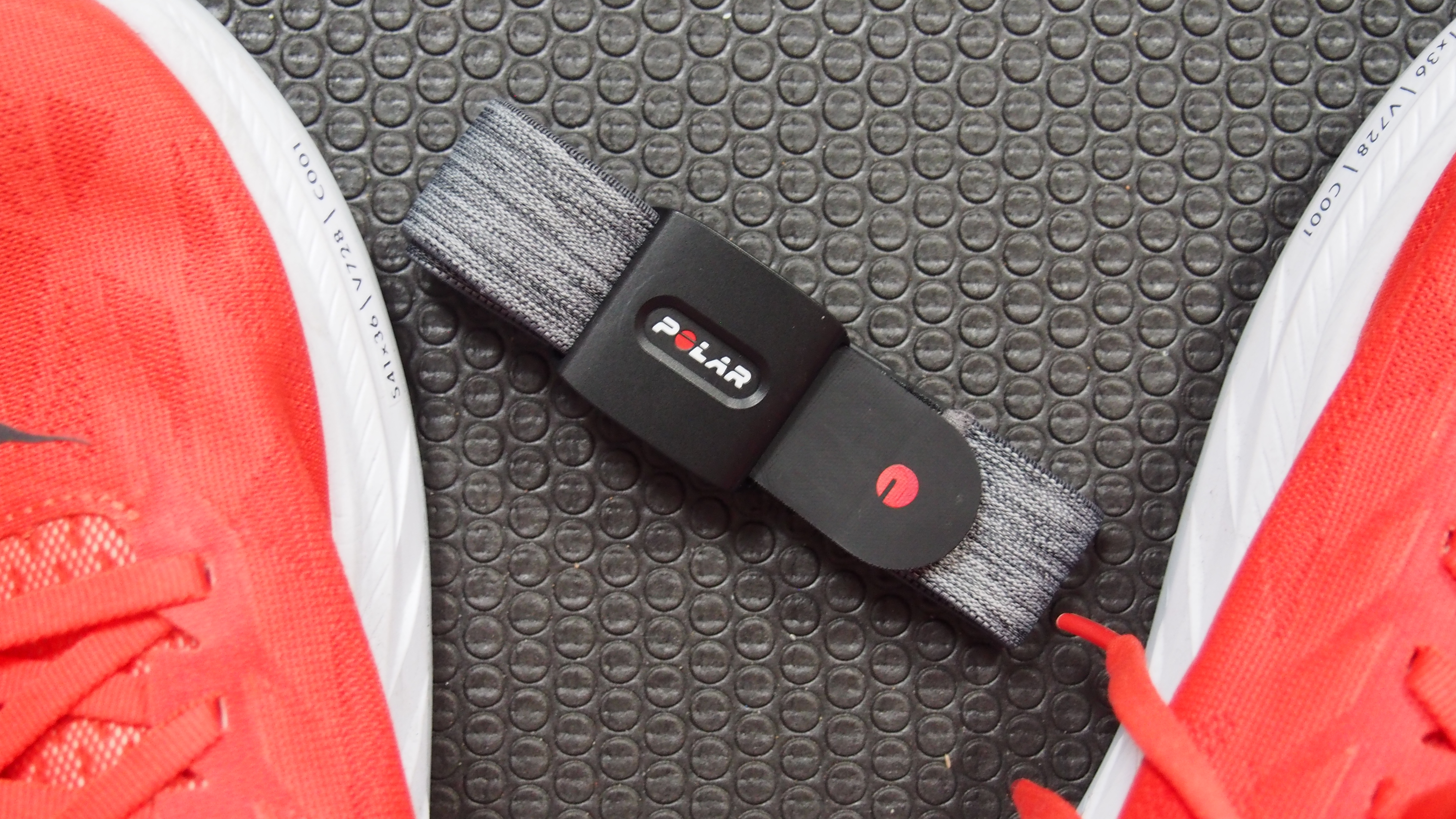
The strap and cradle that holds it in place on your arm has been improved too and is built to make the sensor doesn’t flip over as you workout while the cradle offers a Bluetooth antenna boost when it's communicating with other devices.
Accuracy-wise, it held up well against a heart rate monitor chest strap for a variety of workouts including running, HIIT workouts and indoor rowing sessions. It’s a little fiddly to wear under long sleeves as you’ll need to start tracking before you get moving, so it definitely feels like one better suited for indoor exercise time and when the weather is more t-shirt friendly.
Data can now be synced to Polar’s Flow app, which wasn’t possible with the OH1. Thanks to the Bluetooth and ANT+ connectivity support, it also connected without issue to a Garmin watch and third party fitness apps like Fiit and Apple Fitness Plus.
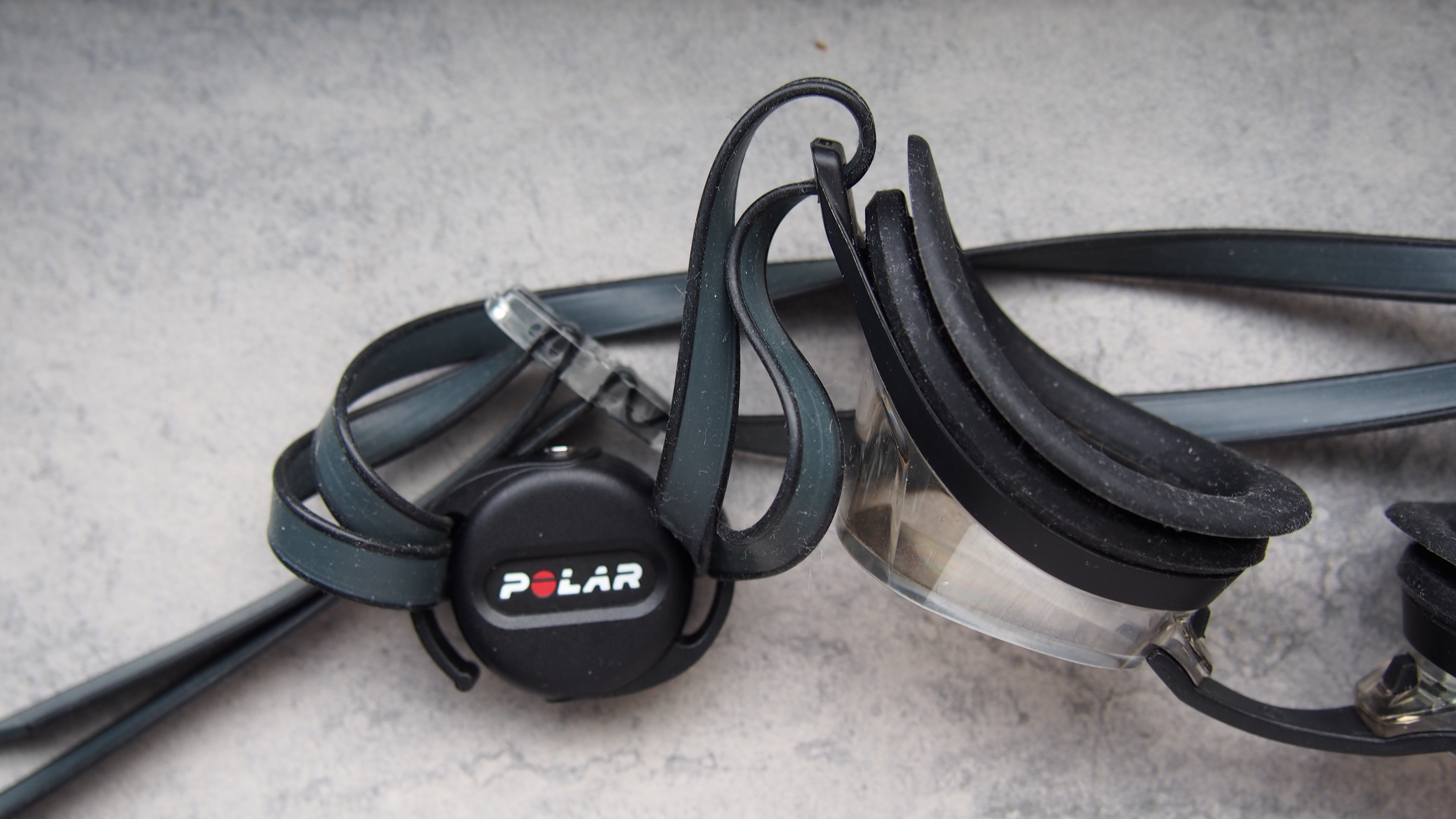
The Verity Sense is set to offer up to 20 hours battery life, which is up from the 12 hours of the Polar OH1. That’s pretty much what we got from it pairing it to other devices and using it on its own.
The Verity Sense on the whole is a solid performer in terms of delivering reliable heart rate from the arm and offers plenty of support to pair it up with a host of devices and apps. While the Wahoo Tickr Fit armband monitor will get you more in the way of battery life, as a package, the Verity Sense feels like a more complete option.
Polar Verity Sense Price and release date
The Polar Verity Sense is available to buy now in one design for $89.95 / £79.50 / AU$129.
Wahoo’s Tickr Fit armband monitor in comparison costs £64.99 / $79.99 / $129.90 while the Scosche Rhythm 24+ costs £99.99 / $99.99 / AU$169.
Polar Verity Sense design
- 30mm diameter
- Waterproof up to 50 meters
- Weighs 12g
The design of the Verity Sense is inspired by the sensor that is at the heart of Polar’s first armband monitor, the OH1. In fact, close-up from the front, it’s tough to distinguish between them and their large coin-sized stature. It’s worth mentioning here that the Sense is not replacing the OH1, which remains on sale.
You still have a single physical button to turn the device on and off, but now there’s a series of small icons that let you use that button to quickly change between the three different modes. The first is transmitting data to another device via ANT+ or Bluetooth. You can do that to two devices simultaneously over Bluetooth and as many as you’d like over ANT+.
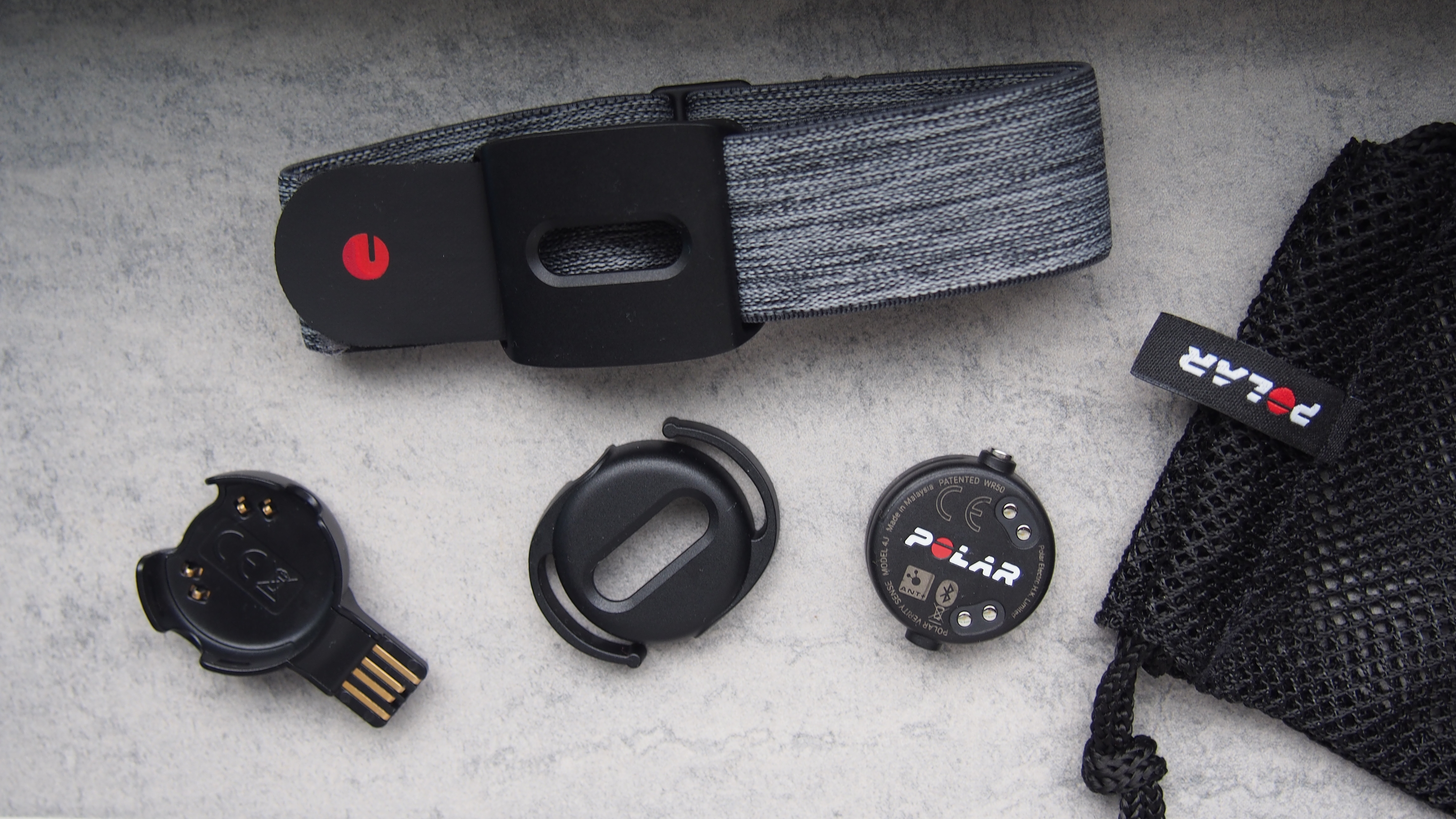
Next up is storing the heart rate-based workout on the device with 16MB of onboard storage, giving you room for 600 hours of training.
The last mode is swimming, letting you use the bundled swimming clip that attaches to your own swimming goggles to monitor heart rate in the pool or open water. It carries a waterproof rating that makes it safe up to 50 metres depth, which should make it suitable for most swimmers.
The sensor technology generating the data is a 6-LED light optical setup, which is the same as the one featured on the Polar OH1. While this is similar sensor technology used on Polar’s watches, moving that technology to a larger surface area further up the arm is seen as reducing artefacts (like motion) that could interfere with readings making it a better place to generate heart rate from.
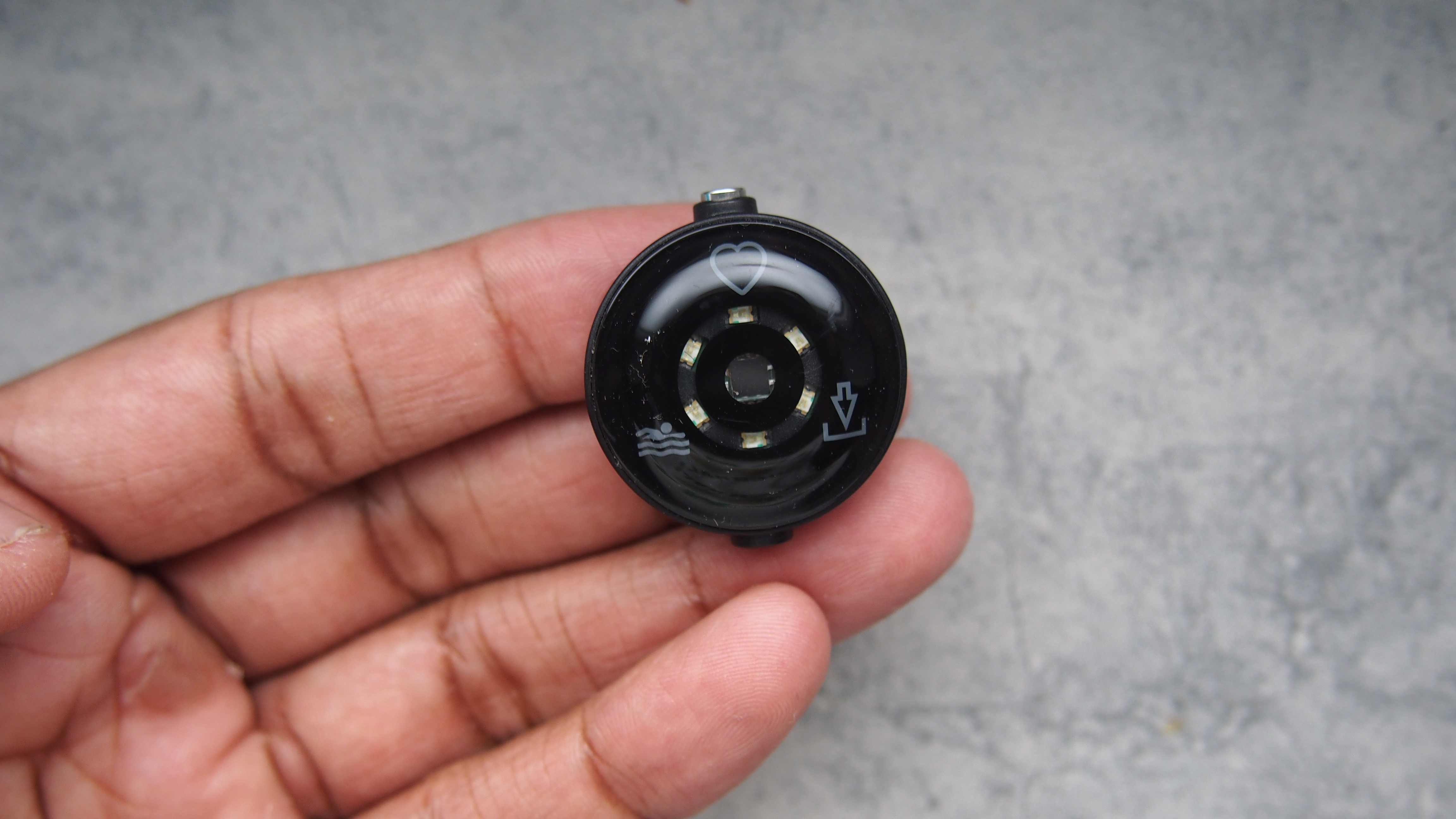
That sensor is clipped and held in place inside of a black cradle that Polar says also acts as an antenna to boost Bluetooth range by 150 metres. This should make it easier to use it with Bluetooth-enabled equipment that’s a little further away from your body.
That’s connected to a stretchy textile armband that uses a velcro strap to secure it in place. It feels like a step up in quality from the one used on the OH1 and crucially, was comfortable to wear during our tests. It’s machine washable too, which is a nice bonus, just make sure you take out the sensor first before throwing it in with your sweaty gym kit.
A couple of minor gripes with the design is that it would be good if the velcro strap was a little larger to accommodate getting a wider range of fits. It wasn’t an issue in our time, but we could see the benefits of making that area on the strap bigger.
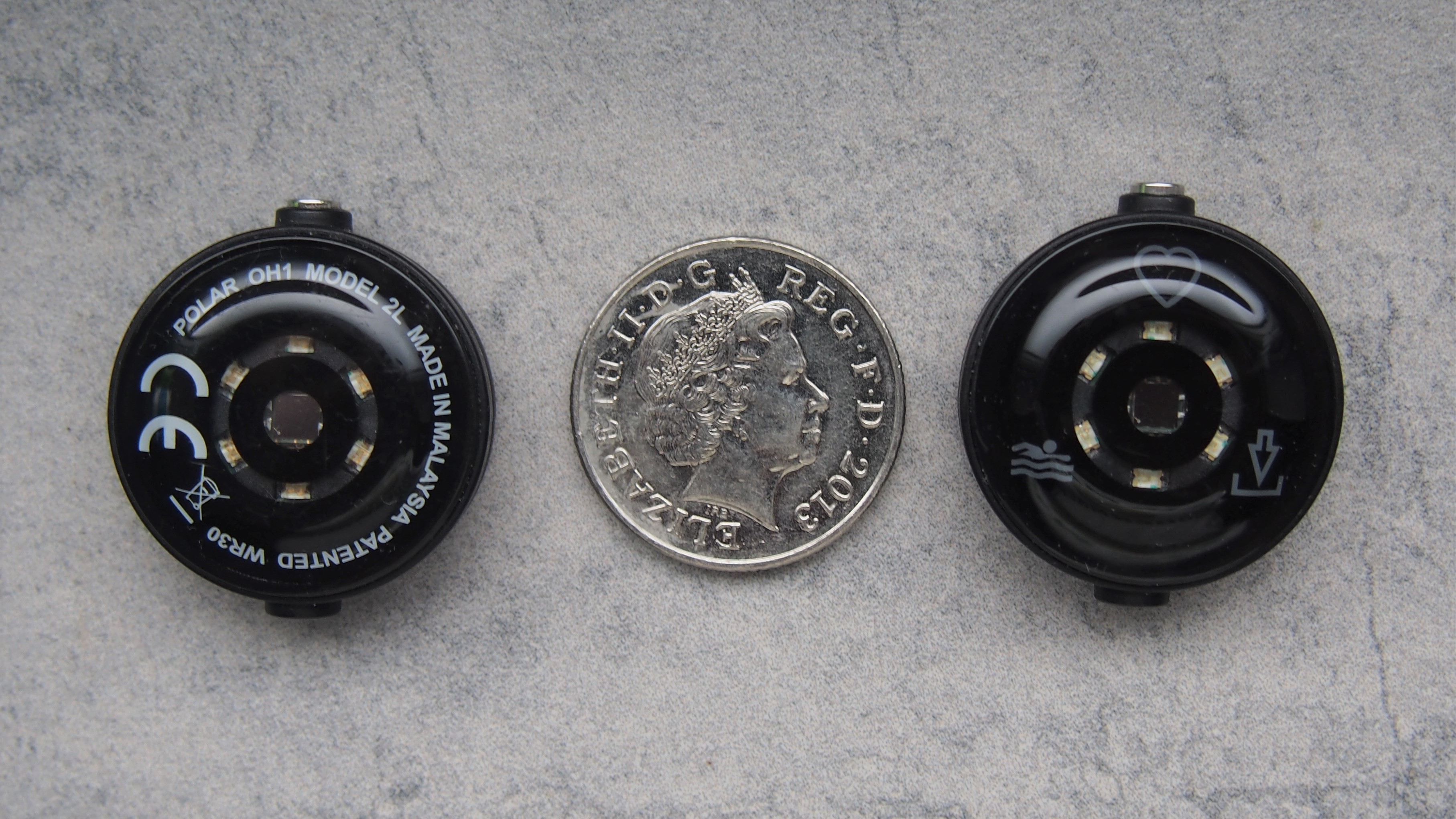
Another thing to consider here as well is that unlike a chest strap monitor, you need to turn this sensor on to start tracking. Trying to do that under a long sleeve top means you might need to start tracking before other devices and making sure you’ve pressed the button long enough to turn it off when your session is done.
Polar Verity Sense performance and app
To see if the Sense was up to the task, we put it to the test for a variety of workouts. We ran steady and at high intensity, used it for home HIIT workouts and indoor rowing sessions. Current lockdown restrictions have meant we weren’t able to get in the pool with it to test its reliability in the water however.
For steady runs, we ran with it alongside a heart rate monitor chest strap, switching between comparing it to a Garmin HRM Pro chest strap and the Wahoo Tickr X. In general, we found that the Sense’s data was generally 4-5bpm out on average readings and within 2bpm for maximum heart rate readings.
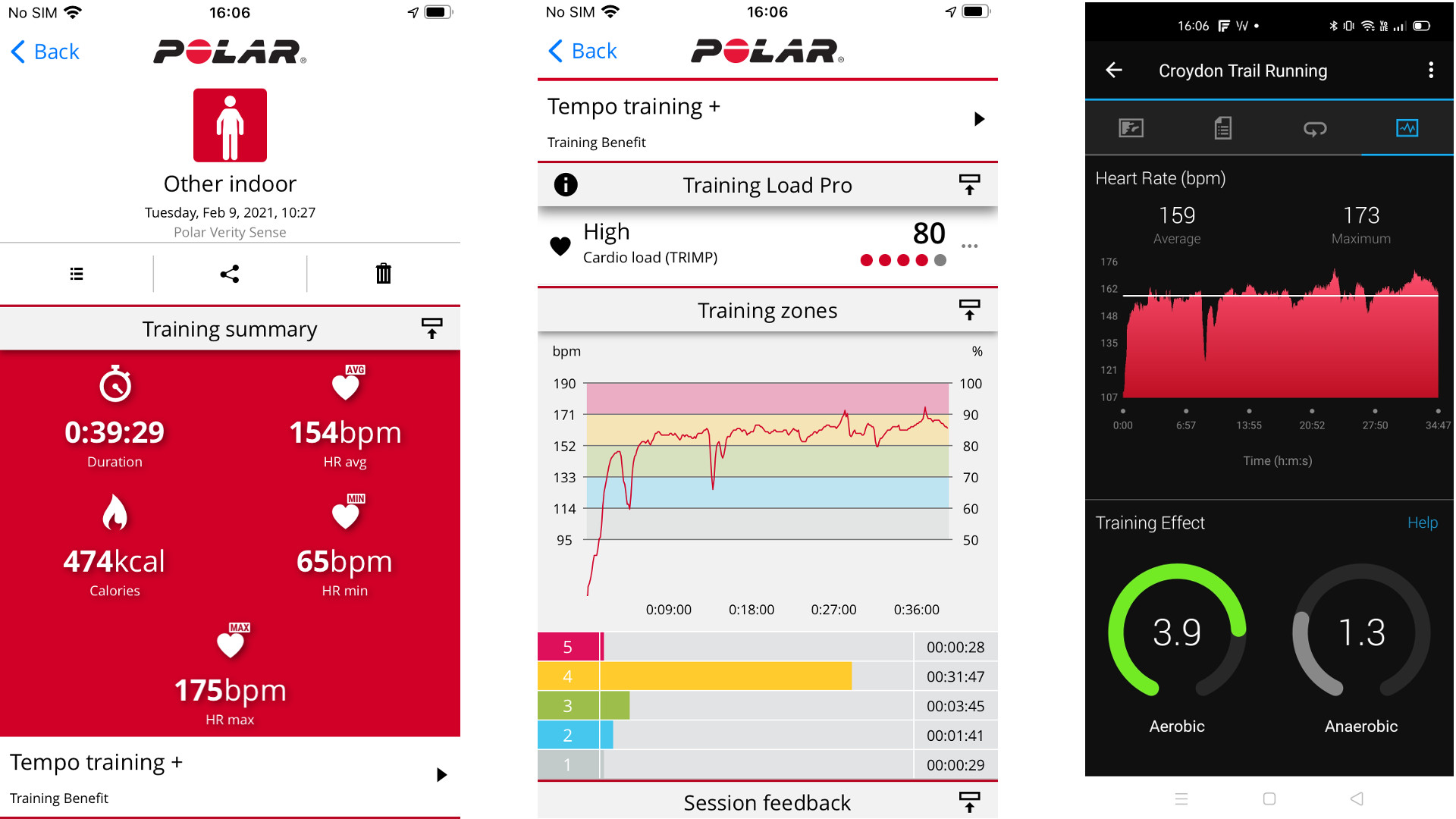
Where we really thought it struggled it actually performed well and that was when we quickly upped the intensity for intervals-based running sessions. In these tests it was within 1-2bpm of a chest strap monitor and the graphs show a very similar story of the session too.
Moving indoors and using it against a chest strap monitor and the Apple Watch Series 6, which is one of the most reliable wrist-based sensors out there, we used it for a series of HIIT workouts using the Fiit workout app. The data showed it matched up for maximum and average heart rate readings. In our indoor rowing tests it was in general 1-2bpm off a Garmin HRM Pro chest strap monitor, which is the kind of margin we could live with.
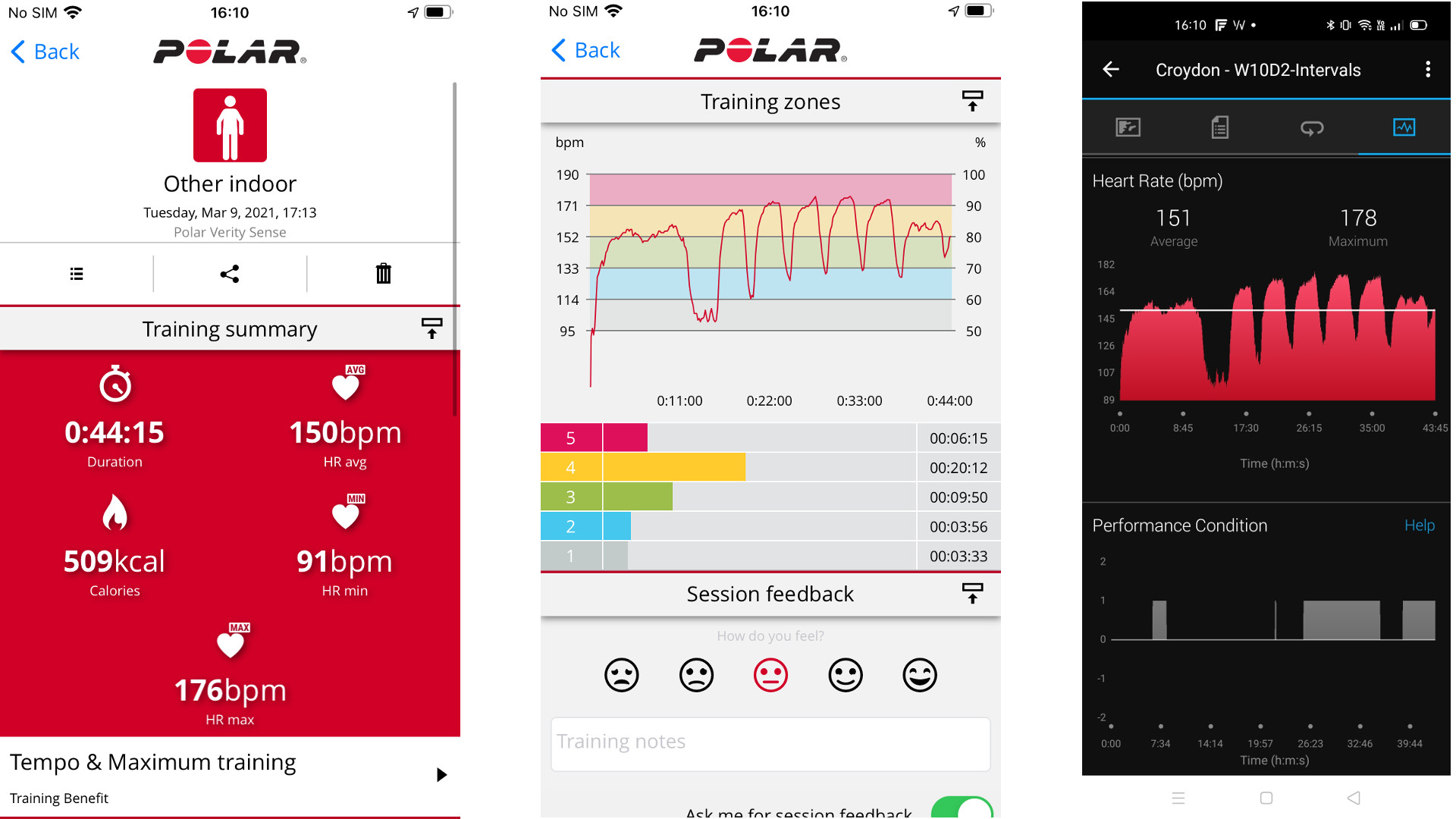
The wider differences in readings on those steady runs feel like they were slightly related to having to set the sensor up earlier than chest straps we put them up against. Across the board though, it performed well. It definitely feels like a better fit for indoor use, but it also delivered when we put it to the high intensity test outside where so many wrist-based optical sensors can badly falter.
If you’re using the Sense with a third party app like Strava or Nike+ Run Club as opposed to Polar’s apps, your data should sync over as normal as long as you’ve correctly connected the two platforms. Polar lets you sync data to its Flow app and Beat app, which wasn’t the case with the OH1, which only offered support for its Beat app. Outdoor sessions though will be logged as indoor workouts unless you choose to transmit data to another device like a sports watch or a compatible smartwatch.
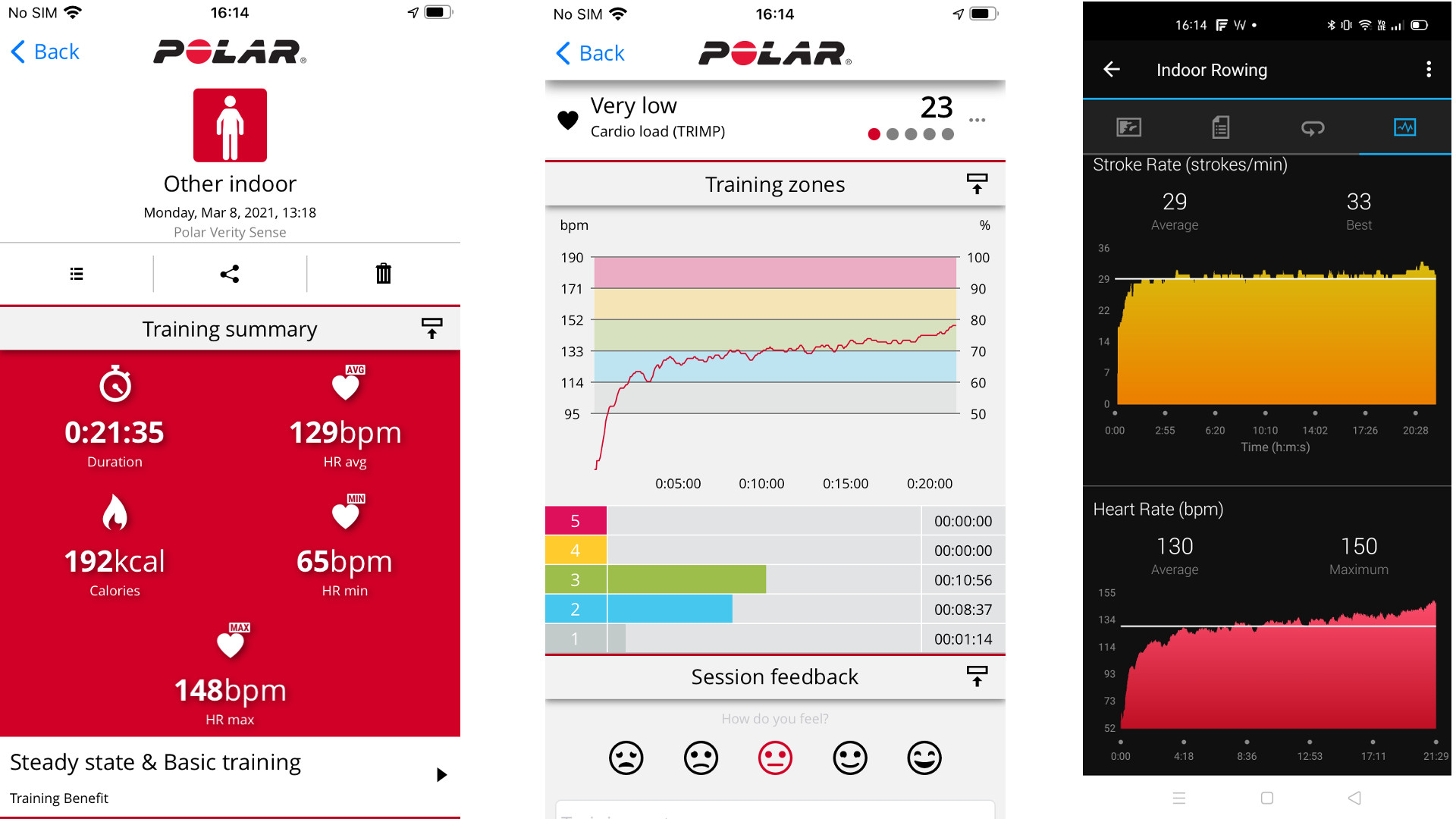
Flow remains a bit clunky in places and its web app definitely feels better optimised than its phone equivalent. Though it’s nice to see that the Sense is compatible. Connectivity and syncing-wise, we had a few teething problems syncing data to an Android phone and it was definitely more issue-free using it with an iPhone.
Polar Verity Sense battery life
- 20 hours on a single charge
- Uses USB charging adaptor
Polar doesn’t specify the capacity of the battery packed into the Verity Sense but does say it should be good to track 20 hours worth of training. That’s up from the 12 hours promised on Polar’s OH1+ armband monitor.
On the device itself, the LED lights on the back of the sensor will blink red slowly when there’s roughly 15% of battery life left and blink quicker when you have roughly 8% of battery left. Polar will be adding a battery level status indicator in the Flow app in a future software update.
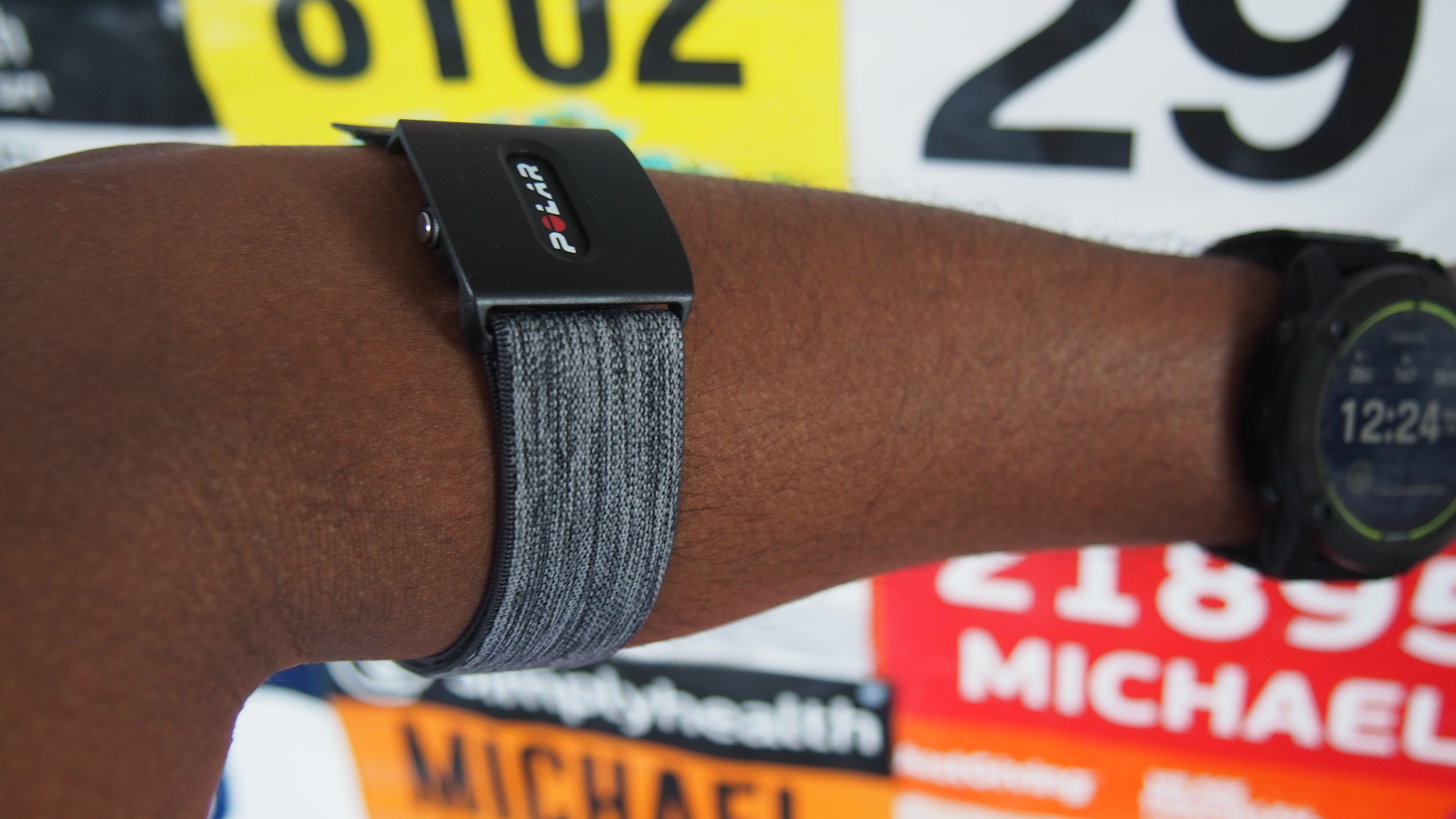
That 20 hours means if you’re working out around an hour a day, you can expect a couple of weeks of battery before you need to charge it and that’s pretty much what we’ve found in our experience. There’s no horrible drop-off whether you pair it with another device or use it on its own.
When it is time to charge, there’s an identical USB cradle to the one bundled with Polar’s OH1 and OH1+ sensor that builds the USB charging port into the cradle. Again, it’s small, which makes it nicer to plug into a laptop, but slightly more annoying for plug sockets. It’s easy to misplace too, which is likely why Polar has now decided to include a small bag to carry the sensor, charger, swimming clip in one place.
First reviewed March 2021
Buy it if
You don’t like chest strap monitors
The Verity Sense holds up well for most activities on the accuracy front making it a good alternative if you don’t trust the heart rate from a smartwatch or sports watch.
You want something for home workouts
If you find a chest strap uncomfortable to wear and want something that can deliver reliable data, the Sense is a good fit.
You want to track heart rate in the water
The useful swimming goggles clip means the Sense can perform on land and in the water too.
Don't buy it if
You want the most accurate heart rate monitoring
Chest strap monitors are still the gold standard for accuracy. The Verity Sense certainly performs well, but we’d still opt for a chest strap.
You layer up your workout clothes
The Verity Sense is definitely better fit for when you have easy access when you need to start tracking instead of feeling for the button to end a workout.
You want months of battery life
Unlike heart rate monitor chest straps, you’ll need to charge the Sense every few weeks if you train regularly with it, and try not to lose that tiny charging cradle.
- Check out our complete guide to the best fitness trackers
0 comments:
Post a Comment